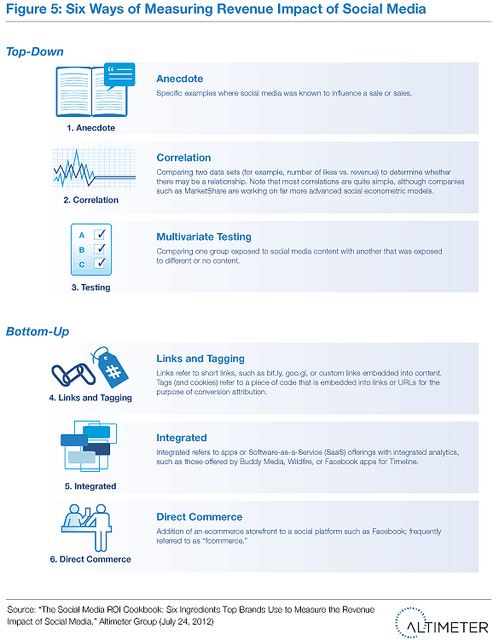
Measuring digital advertising is relatively easy and
Owned and earned media? That’s a whole other story. The metrics and the methods for measuring digital marketing are less exact, the platforms are newer, while the old rules and models don’t apply.
It’s been easier to groan about “lack of analytics expertise and/or resources,” “poor tools,” “unreliable data,” or “inconsistent analytical approaches” than to roll up collective organizational sleeves and really tackle the social media measurement problem. Yet with creativity, as well as hard metrics and defined business goals and strategies, organizations are not only measuring social media for ‘soft’ metrics such as brand sentiment, but also ‘hard’ data, such as revenue attribution.
My Altimeter Group colleague Susan Etlinger has been researching the topic and just published the result, “The Social Media ROI Cookbook: Six Ingredients Top Brands Use to Measure the Revenue Impact of Social Media” (available as a free download under the Open Research model).
While there’s admittedly no perfect measurement method, the study identifies no less than six models for measuring social media revenue impact, three “top-down,” and three “bottom-up.” The organizations that measure most effectively use a combination of these methods in concert, and the report provides a four-factor matrix to help determine which of the six methods apply, based on type of business, the product or service, media mix, and customer profile.
The media mix is of particular interest here, as my focus has been on the convergence of paid, owned, and earned media recently (the topic of my newest research report). Converged media models also require converging metrics, presenting the not inconsiderable challenge of applying findings and learnings from paid and owned, for example, into earned media. Or vice-versa, often in real or near-real time.
Like measuring social media ROI, these models are only just emerging. Measuring new media models is complex enough. The new necessity of measuring, learning, optimizing and applying data from one channel to another makes the challenge geometrically more formidable.
.
